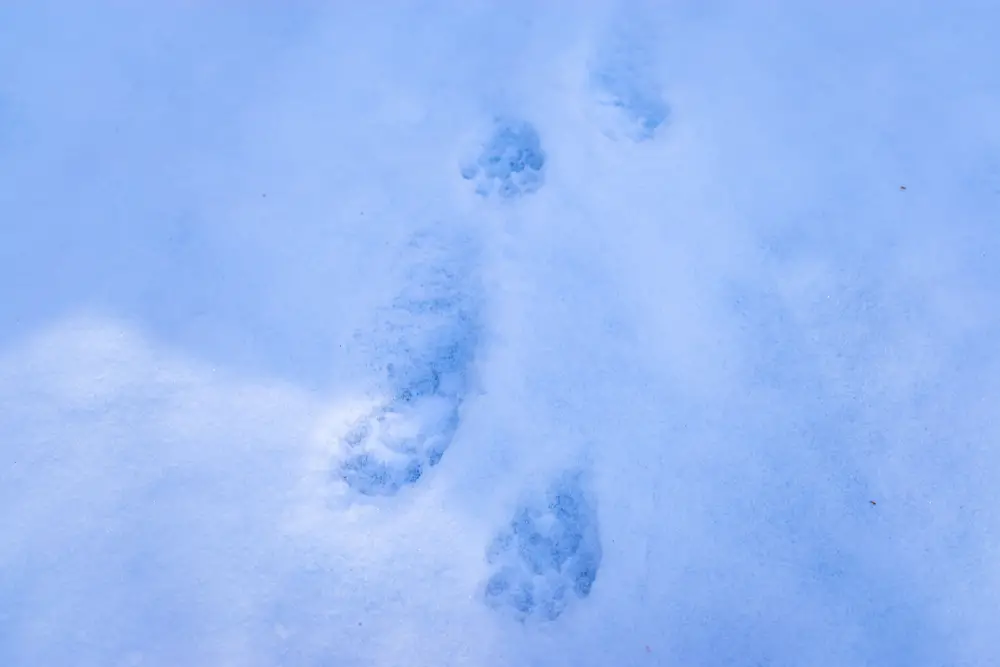Skunk tracks feature five toes on the front and back paws, which is known as plantigrade. Their extended front claws show prints further ahead of the toe marks than the hind prints.
Most people recognize a skunk’s white and black coloring and its unforgettable and offensive stench. However, you can also use skunk tracks or footprints to identify the presence of a skunk on your property, garden, or yard.
Skunk tracks can be found in various habitats, including deserts, open woodlands, parks, suburbs, fields, and farmland. They’re nocturnal and omnivores meaning they consume berries, bird eggs, fruit, small mammals, baby birds, carrion, and invertebrates.
Table of Contents
What do skunk tracks look like?
Like bears, opossums, and raccoons, skunks walk with their feet flat on the ground. This is known as plantigrade, with five toes on the front and five on the back. The tracks of a stripped skunk paw print look like a miniature bear, with the front feet having long claws showing up as dots ahead of the toes.
The hind limb has an enlarged heel pad appearing long and rectangular and is between 2 and 2.5 inches long. A skunk has more extended claws on the front feet as a tool to dig for insects and roots, explaining why the front tracks show claw marks further ahead of the toe marks than the hind skunk footprints.

Do skunk tracks look like cat tracks?
Skunk tracks are easily confused with those of your pet house cat. Skunk tracks look like cat tracks, but skunks have five toes while cats have four. They are the size of the usual house cat.
Skunks average 22 to 26 inches in length, including the tail, and weigh around 3 to 12 pounds. Cat prints are small; usually, 1 to 5 inches, and they tend to meander while walking and don’t try to preserve energy.
How big is a skunk footprint?
A striped skunk has front tracks approximately 1.5 inches long and 1.25 inches wide. They have hind feet around one and a quarter inches wide and can reach around two inches.
Skunks usually have a reasonably wide footpad compared to other critters of the same size. They also have large and rectangular heel pads on their back feet and a second, smaller pad behind them that appears as one dot.
When it comes to gait, striped skunks can use a variety of gaits and travel across open areas in a lope. On the other hand, when moving slowly in search of their favorite insects, plants, fruits, and carrion, they can travel in a walk, often an overstep walk.

What to do if you identify skunk tracks around your house?
If you identify skunk tracks around your house, you should not take it lightly. You need to look for effective removal and preventative measures.
It’s suggested to call a pest control expert to assist with the removal. However you can also use the following preventive measures to repel skunks from your home:
- Ensure the outdoor garbage cans and trash cans are tightly sealed off
- Store any bird seed and pet food in airtight containers
- Feed your pets inside if possible
- Remove food sources such as pest problems to eliminate skunk prey
- Remove rock piles, wood, logs, and other potential den areas
- Fix or fill in holes in your yard, home foundation, and other crawling spaces
- Fence around your property to ensure skunks can’t dig under

Are skunks dangerous?
Like many wild animals and pests, skunks can be dangerous. They carry rabies representing around twenty-six percent of all wildlife rabies cases in Northern America.
Skunks are wild animals with quite a bad reputation because they can spray humans and pets with their putrid-smelling spray. Skunks have special glands under their tails that make the oil spray known as skunk musk.
The spray can in fact reach up to ten feet and be felt a mile away. This stench can linger for weeks and even months if not removed immediately. Skunks will also dig holes in your garden, searching for grubs, insects, rodents, carrion, eggs, and other small animals.
Skunk scat is another danger as it carries harmful and dangerous bacteria and viruses that can be transmitted to people and pets. Skunk poop can harbor hazardous parasites that can be infectious for days or weeks after deposit.
Therefore, proper disposal and handling are crucial when handling skunk poop. Skunks also harbor parasites both externally and internally.
Roundworm, tapeworm, flukes, lungworm, fleas, lice, and ticks are other dangers skunks pose. These parasites carry their own pathogens that cause serious health issues in humans and pets.

